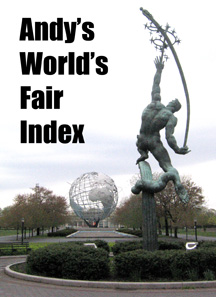 Andy's World's Fair Index Andy's World's Fair Index
I love World's Fairs. I'm particularly fond
of the New York World's Fair of 1964-65, which I attended as
a baby. I have a collection of second-hand
World's Fair souvenirs which fills up 5 boxes,
but my favorite artifacts are the ruins left behind in Flushing
Meadows, Queens. Every few years I like to visit the old fairgrounds,
to inspect the remaining landmarks, like the Unisphere,
the Rocket Thrower, the New York State Pavilion,
the Time Capsules, the Hall
of Science, the Court of the Universe,
and others. This page features photos and
commentary on these World's Fair ruins.
More recently, I've become obsessed with Expo
'67.
Here are some links to other World's Fair-related
pages at Wunderland.com:
|
The Unisphere
The symbol and center of the New York World's Fair is this
120 foot diameter globe, made of stainless steel. Like the fair
as a whole, it stands in the same spot as did the theme center
of the 1939 NYWF, which was the Trylon & Perisphere. (In
1989, I imagined a 3rd NYWF, taking place in the same spot, with
a hybrid symbol, the Trylon
& Unisphere, which would be created just by building
a new Trylon next to the Unisphere. I even created a simulated
guidebook for this imaginary World's Fair, as part of a live-roleplaying
game I was helping write. I still have a few of those guidebooks
around... perhaps I'll put them up on eBay.)
|
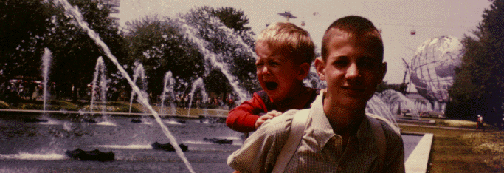
Here's a picture of me
enjoying the New York World's Fair in 1965, with my big brother
Howard. As you can see, the experience made a big impression
on me...
|
|
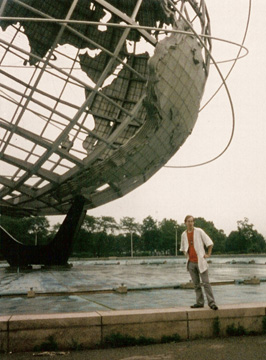 |
The New York State Pavilion
The biggest structure besides the Unisphere is the remains
of the New York State pavilion, with its Jetsons-style towers,
which anyone who's seen the film Men
In Black will recognize.
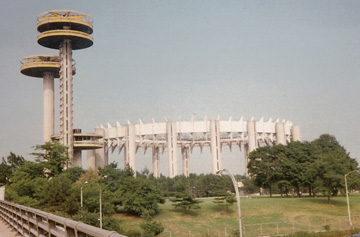
As of my
most recent visit, it was no longer possible to wander around
inside the open air arena of the NY State Pavilion, as I had
in the late 1980s, when these photos were taken. The floor of
the pavilion featured a huge terrazzo map of New York, with handy
markers showing you where all the Texaco stations in New York
are located. (Guess who was a sponsor?)
|
|
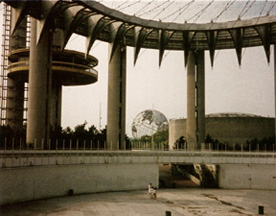 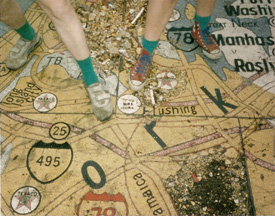 |
|
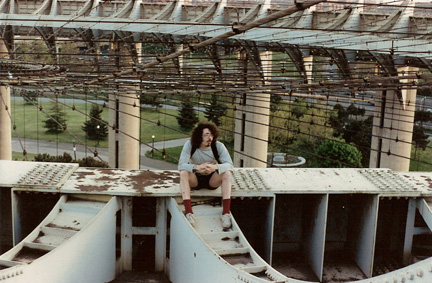 Sadly, the giant
map on the floor is crumbling away. When I was there in 1986,
you could still read "You Are Here" in an appropriately-positioned
circle on the map (near the feet in the photo shown here, said
feet belonging to my brother Jeff and my college girlfriend Amy).
But on a later visit, the floor had been stabilized, by scraping
out all the loose, gravely bits and filling in the gaps will
plain concrete. Now, you aren't even allowed in there anymore,
so I couldn't tell how much further the map had deteriorated.
(There were signs on the gates saying "Danger: High Voltage"
but I suspect that's just a scare tactic.) Sadly, the giant
map on the floor is crumbling away. When I was there in 1986,
you could still read "You Are Here" in an appropriately-positioned
circle on the map (near the feet in the photo shown here, said
feet belonging to my brother Jeff and my college girlfriend Amy).
But on a later visit, the floor had been stabilized, by scraping
out all the loose, gravely bits and filling in the gaps will
plain concrete. Now, you aren't even allowed in there anymore,
so I couldn't tell how much further the map had deteriorated.
(There were signs on the gates saying "Danger: High Voltage"
but I suspect that's just a scare tactic.)
When I visited the fairgrounds some years ago with Chris Welsh,
access to the inside of the New York State Pavilion was still
possible, so much so that Chris figured out a way of getting
inside one of those big support columns, inside of which was
a staircase leading to the top. Nothing I could say would stop
Chris from climbing up there; instead, he persuaded me to tag
along, which is how I got this photo. (What he really wanted
was to find a way up into the flying saucer observation platforms,
but this wasn't possible.)
Notice how you can see the Court of the Time Capsules behind
the pavilion (to the right of Mr. Welsh).
|
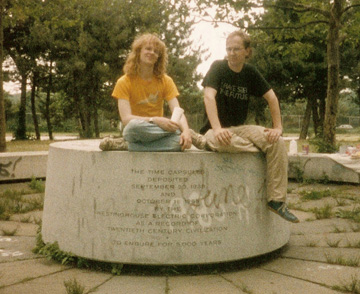 The Time Capsules The Time Capsules
One of the most popular exhibits at the 1939 New York World's
Fair was the Time Capsule buried at the Westinghouse pavilion,
which was intended to be "a record of Twentieth Century
Civilization, to endure for 5000 years." For the 1964 fair,
Westinghouse repeated the stunt, burying a second torpedo-shaped
capsule in the ground next to the original one. The site is marked
now by a granite marker in a quiet grove of trees just behind
the New York State Pavilion. It's a spot I always love to linger
in, trying to imagine the world of 5000 years from now.
The marker is sometimes the target of graffiti; I'm happy
to report that it looked much cleaner during my most recent visit
than in does in this photograph, of me and Number
12, which was taken in 1988. (My T-shirt says "I Have
Seen The Future," which was the slogan of the General Motors
Futurama, which was a wildly popular pavilion at both fairs.)
My fascination with the Time Capsules has been reflected in
my writings on a couple of occasions. My story "The
5000 Year Legacy" was inspired by these Time Capsules;
that story later inspired the nanofiction entry for Zane
Reenak's Lost
ID story. (My fascination with the New York World's Fair
in general is highlighted in another story I wrote back then,
called "The
Timeless Curio Shop.") I've even been known to build
Time
Capsules myself...
|
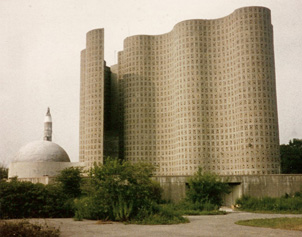 The
Hall of Science The
Hall of Science
This is one of the only pavilions that was actually intended
to remain in the park as a permanent structure after the fair
was over. It's now a popular hands-on science museum, which was
been greatly expanded since I took this photo in the late 80s.
The tip of the Atlas rocket seen in this picture is one of several
pieces of rocket hardware that were donated to the fair by NASA
and which are still on display in the Museum's Space Park.
The Great Hall may look drab on the outside, but the view
inside is really grand. Those curving walls are laced with pieces
of small blue glass, so that when you're inside, with the sunlight
shining through, the walls are like massive stained-glass windows.
Originally, there were spacecraft hanging from the ceiling in
here.
Kristin's fondest memory of visiting Flushing Meadows was
the time, I think it was in 1994, when we encountered a fascinating
art installation that had been set up in the Great Hall, called
Chirping and Silence. It's rather difficult to describe, but
it was really cool. We'd love to know what the artist who created
that is up to now...
|
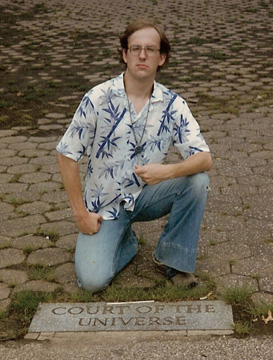 The Court of the Universe The Court of the Universe
The zone in front of the Pool of Industry was called the Court
of the Universe. The area was identified
as such with a small stone marker. (There's a similar little
marker near the statue of the Rocket Thrower which identifies
that area as the Court of the Astronauts.) As you can see in
this photo from 1988, the Court of the Universe was originally
paved with a bunch of small hexagonal bricks (just like the ones
that used to cover the plaza outside the Undergraduate Library,
for you University of Maryland alumni).
Since my last visit, the hexagonal stones have all been removed
and replaced with simple blacktop pavement. In the process, they
damaged the Court of the Universe's marker pretty badly, but
at least it's still there.
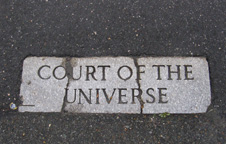
|
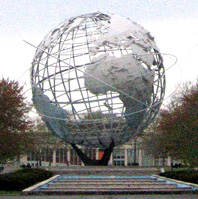 Other
Relics of the Fairs Other
Relics of the Fairs
These are just a few of the statues and structures that linger
in Flushing Meadows-Corona Park. There are a bunch of other sculptures
and markers and relics to discover while wandering around the
park. There's a column from the Temple of Artemis on the site
of the Jordan pavilion, and a little shrine commemorating the
location of the Vatican pavilion, and of course, the Queen's
Museum, which stands directly behind the Unisphere and is the
only building from the 1939 fair that still remains. It was the
New York City pavilion in 1964, and the huge scale model of the
city, which was the pavilion's main offering, is still on display
inside.
There's still a lot to see at the old fairgrounds, for anyone
who wishes to take an imaginary journey to a pair of the world's
greatest World's Fairs. Check it out someday if you're ever in
the neighborhood.
|






 Sadly, the giant
map on the floor is crumbling away. When I was there in 1986,
you could still read "You Are Here" in an appropriately-positioned
circle on the map (near the feet in the photo shown here, said
feet belonging to my brother Jeff and my college girlfriend Amy).
But on a later visit, the floor had been stabilized, by scraping
out all the loose, gravely bits and filling in the gaps will
plain concrete. Now, you aren't even allowed in there anymore,
so I couldn't tell how much further the map had deteriorated.
(There were signs on the gates saying "Danger: High Voltage"
but I suspect that's just a scare tactic.)
Sadly, the giant
map on the floor is crumbling away. When I was there in 1986,
you could still read "You Are Here" in an appropriately-positioned
circle on the map (near the feet in the photo shown here, said
feet belonging to my brother Jeff and my college girlfriend Amy).
But on a later visit, the floor had been stabilized, by scraping
out all the loose, gravely bits and filling in the gaps will
plain concrete. Now, you aren't even allowed in there anymore,
so I couldn't tell how much further the map had deteriorated.
(There were signs on the gates saying "Danger: High Voltage"
but I suspect that's just a scare tactic.)








